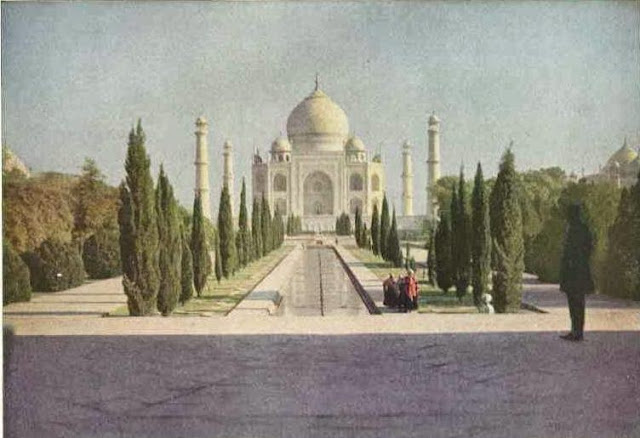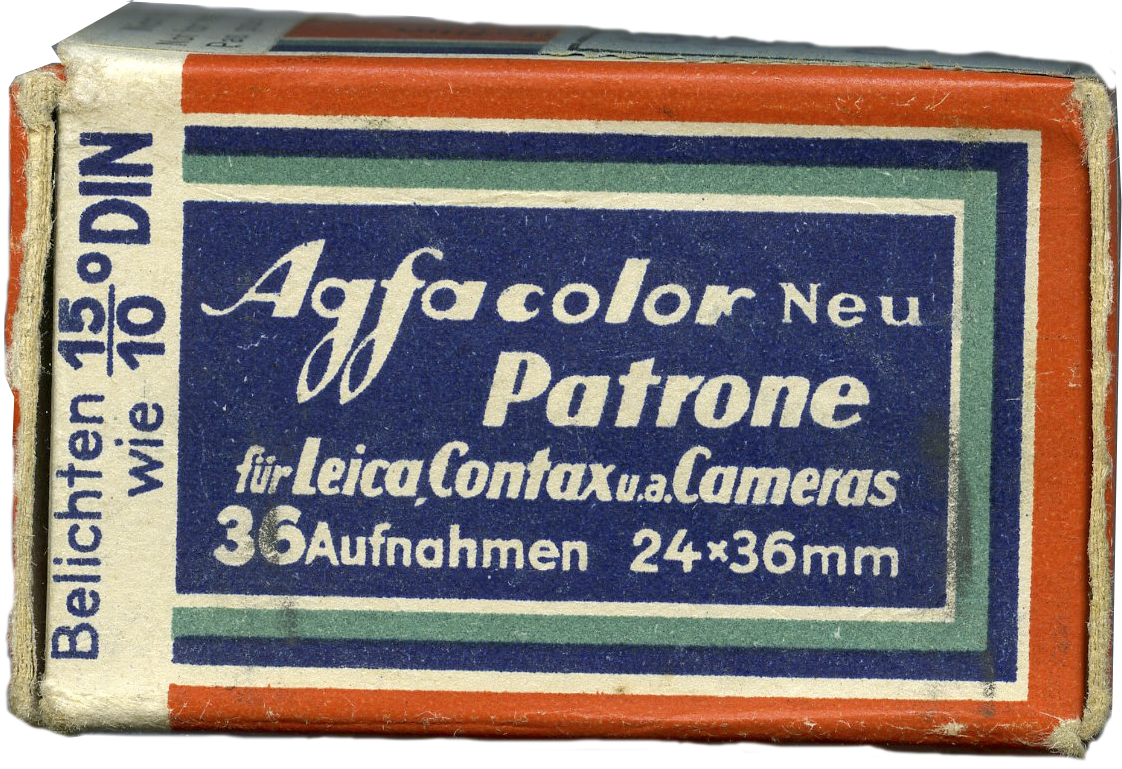Many are familiar with the
history of the Leica and its influence on photography in general. The photographic process Leica relied on
essentially was no different from what we are using today. Many of the early Leica photographs are well
known. Quite a few were taken by Oskar
Barnack, the inventor of the Leica, himself.

Wetzlar Eisenmarkt
Photo: Oskar Barnack
All of these photographs
are in black and white, which brings up the question of color. Were there any color films in these early
days of 35mm photography? For an answer
we need to go back to virtually the beginning of photography in general.
The earliest permanent
photograph in existence was made in 1826 by Joseph Nicéphore Niepce, showing
the roofs and chimneys visible from his workroom. It required an exposure time of eight hours
on a bright, sunny day. He used a pewter
plate with a light sensitive varnish of asphalt (bitumen if Judea) and then
used oils as a fixing agent. During the
exposure, various areas of the asphalt would harden to different degrees. The oils washed away the less hardened areas
of the asphalt, resulting in a recognizable image. The word snapshot doesn’t apply.

Joseph Nicéphore Niepce
photograph from 1826
Niepce’s process proved to
be a dead end. Through the company of
Chevalier, the major manufacturer of lenses at the time, he met
Louis-Jacques-Mandé Daguerre. They
formed a company to research other means to take permanent photographs. Unfortunately, Niepce died before they had
any success. A nephew of his continued to work with Daguerre, but when a viable process was developed, Daguerre took
the credit all for himself. This was the
famous Daguerreotype, first introduced in 1839 to the French Académie des
Sciences. While a lot faster than
Niepce’s first attempts, it still had the drawback of producing just a single
picture at the time. There were no
negatives from which multiple copies could be made.

"Boulevard du
Temple", taken by Daguerre in 1838 in Paris, includes the earliest known
candid photograph of a
person. The image shows a
street, but because of the over ten-minute exposure time the moving traffic
does not
appear. At the lower left,
however, a man having his boots polished had both men motionless enough
for their images to be
captured.
The first successful
negative process was developed by William Henry Fox Talbot in 1840. He used sensitized strips of paper, which,
when developed, resulted in a negative which allowed the contact printing of multiple images. Thus the photographic process closest to what
we use today, was born.

William Henry Fox Talbot,
Laycock Abbey 1847
Virtually as soon as these
processes became available, the quest for color photographs started. The earliest color photographs were actually hand
colored daguerreotypes. Simultaneously,
a number individuals experimented with a variety of processes to produce color
images. Some were met with limited
success while others could not be repeated with any certainty.
The three color process of
red-green-blue, RGB was first used by James Clerk Maxwell in 1861. His picture
“Tartan Ribbon” is generally considered the first durable color photograph, and
the very first made by the three-color method Maxwell first suggested in 1855.
Maxwell had the photographer Thomas Sutton photograph a tartan ribbon three
times, each time with a different color filter (red, green, and blue-violet)
over the lens. The three photographs were developed, printed on glass, and then
projected onto a screen with three different projectors, each equipped with the
same color filter used to photograph it. When superimposed on the screen, the
three images formed a full-color image. Maxwell's three-color approach
underlies nearly all forms of color photography, whether film-based, analogue
video, or digital.

James Clerk Maxwell,
"Tartan Ribbon" 1861
The credit for a valid
color process goes to John Joly. He was
aware that a color image could be formed by mixing just three colors, red,
green and blue, a process still used today in all types of color imaging. He used a glass plate which contained a
ruling of alternating RGB filters, about 200 per inch. This was placed against the glass negative
plate in the camera during exposure.
After developing, the same glass plate was put in register with the
negative, resulting in a color transparency which could even be projected.

John Joly
"Butterflies" 1893
The process worked, but
was relatively cumbersome. Obviously, it
would be a lot easier to do away with the RGB plate and combine the RGB filters
with the emulsion. Such a process was
developed by the Lumière brothers. They
patented their Autochrome process in 1903 and began marketing it in 1907.
Just like Joly’s process,
Autochrome is an additive color process. The medium consists of a glass plate
coated on one side with a random mosaic of microscopic grains of potato starch
dyed red-orange, green, and blue-violet (an unusual but functional variant of
the standard RGB additive colors) which act as color filters. Carbon particles fill
the spaces between grains, and a black-and-white panchromatic silver halide
emulsion is coated on top of the filter layer.
The glass plates were loaded with the filter layer facing the lens. After developing, a color transparency was
the result. Autochrome was one of the
most widely used color photography process in use before the advent of
subtractive color film in the mid-1930s.

RGB colored starch
particles function as a filter


Autochrome Photographs by Lumiere
brothers
A similar process was
developed by Agfa in the 1920s. Instead
of the dyed starch particles, they developed a very fine RGB screen with also
was attached to the glass plate. It too
produced color transparencies. In 1932
Agfa was the first company to offer a film-based version of their
Agfa-Farbenplatte (Agfa color plate), enabling Leica owners for the first time
to take color photographs.

Agfacolor
But there were still
drawbacks. The Autochrome and Agfa
systems were notoriously slow. The RGB
filters absorbed a huge amount of light. Another process was needed to solve that problem.
In 1912 Rudolph Fisher at
Agfa discovered chemicals would react to the silver halides in the emulsion and
convert other compounds into insoluble dyes.
These color forming ingredients, called dye couplers, could be included
in the emulsion. Fisher’s work resulted
in researching three emulsion layers in films to form a color image. Initial trials were unsuccessful because some
of the color dyes migrated from one emulsion layer to the other during
development.
This was also the case with
Leopold Mannes and Leopold Godowsky, who worked at the Kodak laboratories in
Rochester, New York. To solve the
problem, they switched to incorporating the dyes in the developer. This resulted in a breakthrough, and in 1935
the first three emulsion layer color film became reality, the Kodachrome. Because the dye couplers of this film were
added during the developing stage, tghis was a very complicated process and it was necessary to send the film to Kodak
to have it processed.

The original 18 exposure 35mm Kodachrome
The first color film to
incorporate the dye couplers in the emulsion was the Agfacolor Neu (new) in
1936. It was the first time that
photographers were able develop their own color film. The Neu designation was used to distinguish
these Agfacolor films from their previous Agfacolor films. Both Kodachrome and Agfacolor very quickly
spelled the end of Autochrome and other, similar films.

Both Kodachrome and
Agfacolor were available as 35mm films giving Leica owners and owners of other
35mm cameras for the first time a convenient and reliable means to take color
photographs. It is interesting to note
that both companies initially marketed their films with the reference to Leica
and other 35mm cameras. Thus we have a further indication how important the Leica was in creating photography as we know it today.
________________________________________________________________________________________
To comment or to read comments please scroll past the ads below.
All ads present items of interest to Leica owners.


To comment or to read comments please scroll past the ads below.


All ads present items of interest to Leica owners.



For more information on KOMARU and for orders go to: www.taos-photographic.com
NEW Komaru Colors
For more information and pre orders go to: www.lenstab.com
For more information on KOMARU and for orders go to: www.taos-photographic.com
NEW Komaru Colors
For more information and pre orders go to: www.lenstab.com
Click on image to enlarge
Order: info@gmpphoto.com
Click on image to enlarge
Order: info@gmpphoto.com
Click on image to enlarge
Order: info@gmpphoto.com
Click on image to enlarge
Order: info@gmpphoto.com
Please make payment via PayPal to GMP Photography
Click on image to enlarge
Order: info@gmpphoto.com
Please make payment via PayPal to GMP Photography
Click on image to enlarge
Order: info@gmpphoto.com
Please make payment via PayPal to GMP Photography












Do you have any idea how Agfa finally solved the problem of color coupler migration to the other emulsion layers? I understand Kodaks solution with the Kodachrome, but that turned out to be somewhat of a hassle since it required for the film to be sent to a processing lab.
ReplyDeleteI agree that Kodachrome was a bit of a hassle to get processed. That obviously is the very reason why all the other Kodak transparency films later on used essentially the same process as initially developed by Agfa.
DeleteI am not a chemist, but as I understand it, Agfa's solution was in a way ingeniously simple. The emulsion structure of film at that time was relatively coarse as far as the silver halides are concerned. To prevent color coupler migration, they simply made the resulting color couplers large enough that they could not pass the general structure of the emulsion. With other words, the color couplers got stuck in their respective emulsion layers.